Steeped in stories of invaders and sleeping under the spell of a dangerous and heroic past besieged with bloody border clashes, Northumberland today remains a county free from crowds, boasting endless incredible views and a shoreline dubbed the Castle Coast.
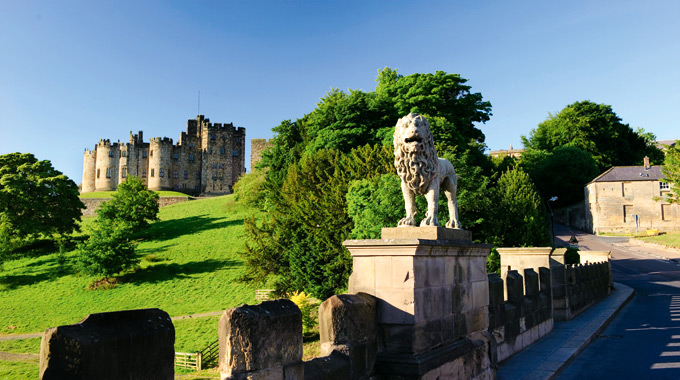
Just 20 miles south of the Scottish border near the village of Chatton stands a 3,000-year-old earthen rampart which offers an unrivalled view across Northumberland – from the purple humps of the Cheviot Hills in the west to the creamy sands swirling around Lindisfarne at the coast. What makes this panorama even more striking is that at certain times of the day, when the light is clear, you can see seven castles. Despite this remarkable vista and proximity to one of Northumberland’s most imposing medieval fortresses and parklands (Chillingham Castle), few people know of Ros Castle – or its view. But then that’s true of England’s northernmost county in general. Where else in the country can you walk for several miles across a pristine sandy beach and only meet a handful of people; gaze at a night sky as starry as in the Scottish Highlands; or strip off and take the plunge under a waterfall knowing there’s no one else around?
Tourism brochures often describe Northumberland as ‘the Secret Kingdom’, which is a bit erroneous these days (the secret has been out for years), but there are still many corners of Northumberland that are relatively unexplored by visitors – and wonderfully crowd free even in high summer.
But let’s turn to a well-trodden path: the most important Roman monument in Britain, Hadrian’s Wall. For 73 miles, the 2,000-year-old barricade crosses the neck of England from Bowness-on-Solway in Cumbria to Wallsend in Tyneside. Though still standing at over two metres high in places, the wall dips in and out of sight, breaks up here and there and disappears completely on the outskirts of Newcastle, but it leads today’s rambler on a journey from the Irish Sea, over the southern edge of Northumberland National Park, and through the leafy Tyne Valley before its final run past the old shipyards on the River Tyne.
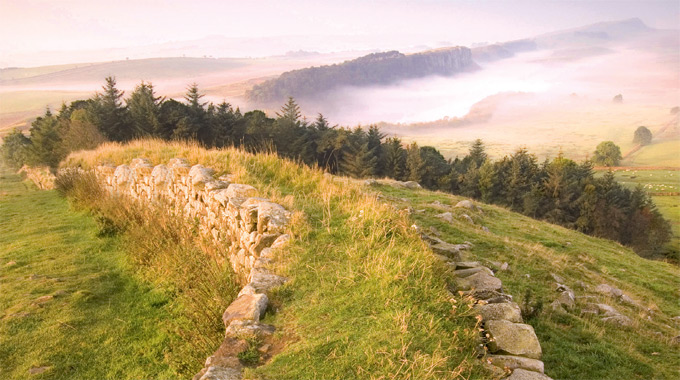
Between Chollerford and Brampton the ruin is particularly dramatic and well-preserved, owing to the inaccessible location and high Whin Sill cliffs (a type of igneous rock peculiar to the North East) that have kept the wall out of the reach of builders over the centuries. Certainly there were easier places to transport Roman masonry than across this rugged terrain. Elsewhere along the line of Hadrian’s Wall, the sharp-eyed will notice that some houses and farmsteads are constructed with suspiciously well-dressed stones. Roman masonry was also widely ‘recycled’ in more prominent buildings such as the Golden Lion pub in Corbridge, Thirlwall Castle near Greenhead and in a number of churches. At Hexham Abbey for example, visitors to the Anglo-Saxon crypt may just make out Roman letters in the stonework above their heads.
Northumberland’s Roman sites have been excavated and studied many times since the ruins caught the attention of Victorian collectors, so it may come as some surprise to learn that archaeologists are still uncovering Roman artefacts today. Nowhere is this more exciting than at Vindolanda Roman Fort near Bardon Mill, which hosts archaeologists every summer. They don’t just unearth fragments of pots or bones, however; buried in the anaerobic soil are wonderfully preserved objects that would normally have rotted away: old sandals, bracelets, hair brushes and, most thrilling of all, postcards with their 2,000-year-old messages still visible.
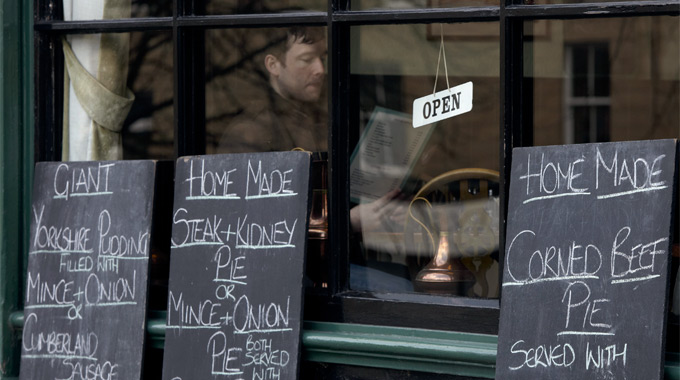
‘I want you to know that I am in very good health, as I hope you are in turn, you neglectful man, who have sent me not even one letter…’ reads one of the now renowned Vindolanda Writing Tablets on display in the fort’s museum. Of great interest to historians is a birthday party invitation from Claudia Severa to Sulpicia Lepidina, which begins: ‘I give you a warm invitation to make sure that you come to us, to make the day more enjoyable for me’ and closes: ‘I shall expect you, sister. Farewell, sister, my dearest soul, as I hope to prosper, and hail’. This is the earliest record of female correspondence and Latin handwriting in western Europe, and the original tablet is kept in London’s British Museum.
A few centuries after the collapse of the Roman Empire, Northumbria entered a long period of cultural enrichment and learning. It was during this period that we see the emergence of new crafts, such as the creation of stained glass windows, the production of Britain’s first history book and the celebrated Lindisfarne Gospels. But turmoil returned to the region when Vikings invaded and again during the years of Border clashes. The medieval period was marked by frequent conflicts with the Scots, hence the large number of fortified manor houses and castles in the North East. Nowhere is this more apparent (except for at Ros Castle) than on the shores between Druridge Bay and Berwick upon Tweed, an area dubbed the Castle Coast.

Warkworth, Dunstanburgh, Bamburgh and Lindisfarne appear one after the other, where beaches – largely free of development and crowds – extend for miles. Dunstanburgh and Warkworth are both ruins today with their ribcages exposed to the sea air, though they still bear their formidable chests; Bamburgh and Lindisfarne (a relatively young castle built in 1542) remain largely intact and reflect in their walls and furnishings the changing periods and styles since their construction. Internally, Lindisfarne comes as quite a surprise with its Edwardian interior designed by Edwin Lutyens.
A few miles inland, the region’s most visited castle, Alnwick, is a fortress to be reckoned with. A 19th-century guidebook purchased from Alnwick’s delightful second-hand bookshop, Barter Books, says the market town ‘is ever under the spell of the dreamy past’. These days you could say it is also under the spell of Harry Potter, this being the setting for Hogwarts in the film adaptation of JK Rowling’s bestseller. Witchcraft and wizardry aside, Alnwick Castle is stuffed with riches amassed by Northumberland’s most powerful aristocratic family, the Percys, and the town itself is a hugely rewarding stop on the heritage trail. Don’t miss the view of the castle from near Lion Bridge, or the splendour of the White Swan hotel dining room on Bondgate, which is lavishly fitted with all the fixtures and artworks from the Titanic’s sister ship, the Olympic. The room will take you back to the era of trans-Atlantic cruises and Edwardian style.
To see where many of the region’s legendary battles took place, however, head away from the Heritage Coast to Redesdale, an expanse of open countryside between Kielder Forest and Otterburn that has experienced more bloodshed than probably anywhere else in Northumberland. For a couple of hundred years until the mid 17th century, this was the Wild West of Britain, a lawless place where marauding clans in England and Scotland, who had stronger ties to family groups than to country, rode on horseback at night over the moors, stealing livestock, committing murder and arson and seeking retribution. ‘They were cruel, coarse savages, slaying each other as the beasts of the forests,’ wrote GM Trevelyan of the notorious Border Reivers. Today, Redesdale’s bleak grasslands, heather hills and dark woods are somewhat off the beaten track, but this is a fascinating – and beautiful – part of the county with a gripping story to tell. Reminders of Redesdale’s turbulent years are still visible in the buildings standing to this day, and the legacy of the Reivers lives on in folklore, traditional North East songs and in a few local words that became adopted into mainstream English including ‘bereaved’ and ‘blackmail’. A strong culture of story-telling emerged during this period, but tales of clashes, villains, love and tragedies were not written down; they were preserved in song. Sir Walter Scott recorded some of these melancholic Border Ballads before they became extinct.
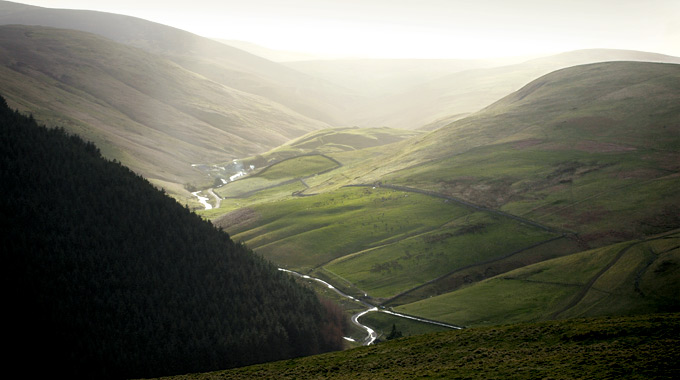
Equally as fascinating are the defensive buildings from that period that survive in the hills. ‘Bastle houses’ were domestic dwellings with hugely thick stone walls that typically had their front door on the first floor, which was reached by an external stone staircase or ladders that could be brought in at night. These distinctive buildings are dotted all over Northumbria. Some, like Black Middens Bastle in the Tarset Valley and Woodhouses Bastle near Holystone are exceptionally well preserved; others have been converted into domestic houses or storage buildings and require a bit of local knowledge and detective work to spot. Helpfully, the Tourist Information Centre has a leaflet marking their locations.
With so many castles, fortified houses and town walls, Northumberland can seem formidable, but the county does have a gentle, more refined side. By the 18th and 19th centuries, relatively peaceful times prevailed and wealthy landowners abandoned their defensive towers and built neo-classical houses with large welcoming windows and open parklands. Wallington Hall and Belsay Hall in the lowland countryside around Ponteland and Morpeth are both open to the public. Here the wind blows less punishingly than in rugged Redesdale and the scenery is softer with grazing sheep and well-kept villages glimpsed across parklands. Local landscape designer, Capability Brown, must have drawn inspiration for his garden designs from this scenery.
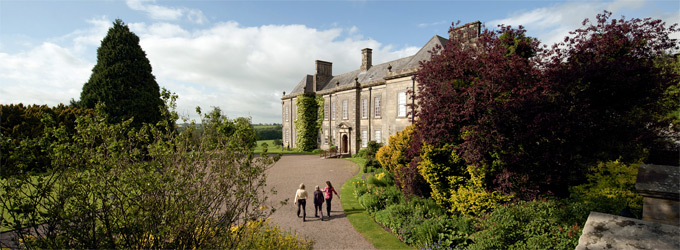
Brown was born in Kirkharle near Ponteland and walked across the hay meadows you see today on his way to school. A plan for the parkland at Kirkharle farm, which is almost certainly Brown’s work, was discovered in the 1980s, but it was only recently that his vision was realised. It will be decades before the garden reaches maturity, but Kirkharle is already a tranquil spot with a lake and broad-leaved trees. Perhaps emperor Hadrian and the medieval kings and dukes of Northumberland had similar ideas when they looked upon the Whin Sill crags and envisioned their walls and castles.
| Related articlesMade in Britain History of Syon House Discover Liverpool Inside Britain’s palaces |
Click here to subscribe! |


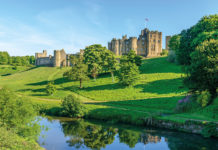
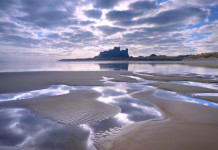

 © 2024
© 2024